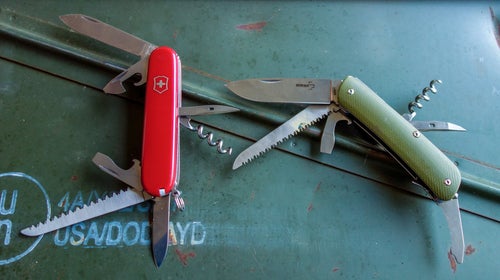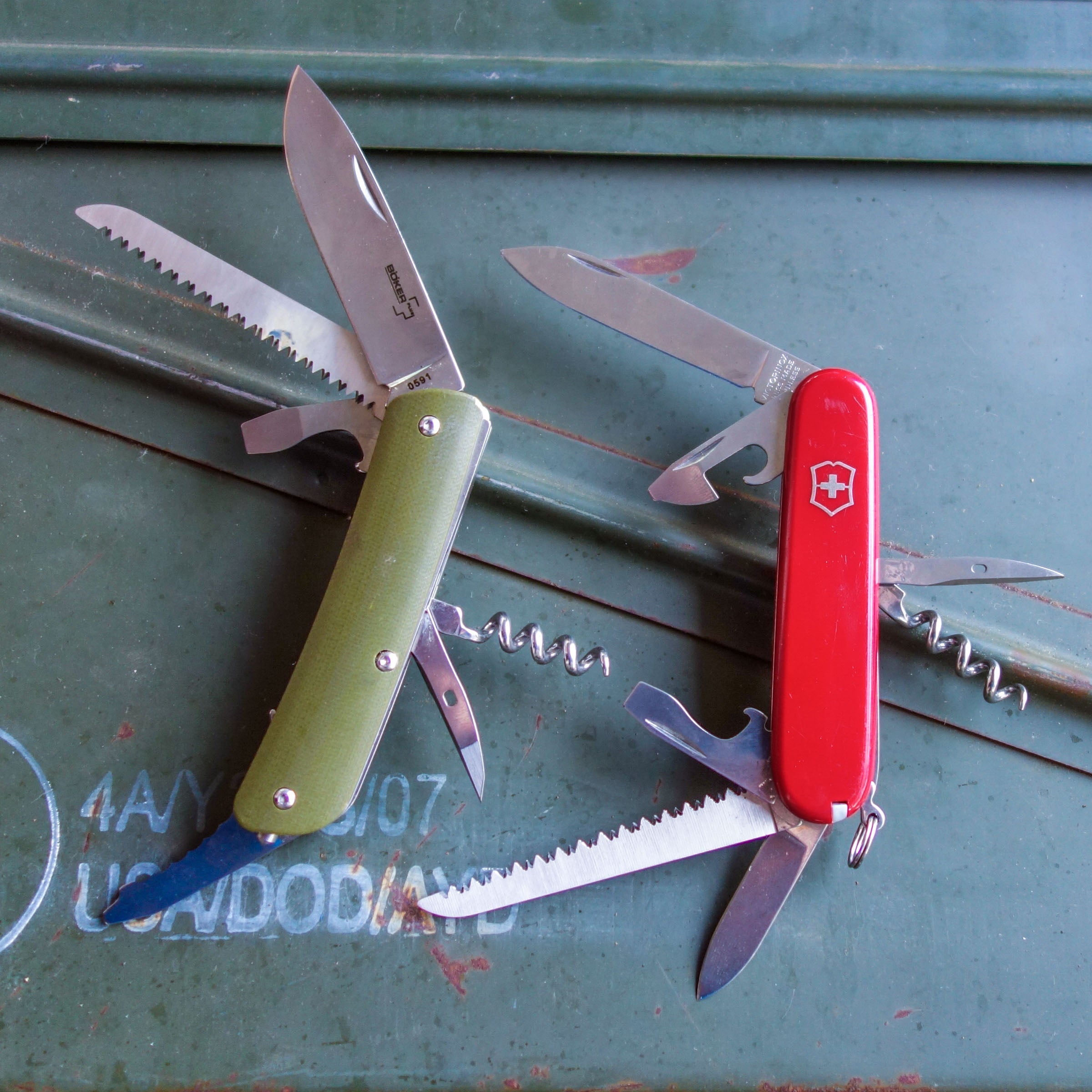It’s hard to think of a more ubiquitous or more loved outdoor tool than the Swiss Army knife. Victorinox produces 34,000 of them each day. There’s one in the Museum of Modern Art and, odds are, there’s one in your pocket, backpack, or glove box right now. But being popular doesn’t mean they’re perfect. And this new knife from Boker may have improved on the iconic design.
IndefinitelyWild
 IndefinitelyWild is a lifestyle column telling the story of adventure travel in the outdoors, the vehicles and gear that get us there, and the people we meet along the way. Follow us on , and .
IndefinitelyWild is a lifestyle column telling the story of adventure travel in the outdoors, the vehicles and gear that get us there, and the people we meet along the way. Follow us on , and . Back in the late 1800s, the Swiss Army decided to commission a new tool for its soldiers. The knife needed to fold for easy and safe carry in a pocket, be able to open a can of rations, and come with the necessary tools to disassemble the army's standard-service rifle. Over the subsequent 123 years, the basic design has evolved into many new versions, but they're all still made by Victorinox in Switzerland. The Swiss Army actually uses , but they carried the same Swiss Army knife as you until 2008.
There are now lots of everyday carry knives, many of which have larger, stronger blades or more robust tool sets (including a full-size set of pliers) than the original Victorinox. But those larger blades and ��������-��������������ܱ��پ��ٴǴDZ�����often seem threatening and unfriendly. So the Swiss Army knife endures. There are better knives and multitools out there, but none pack the same quality or usefulness into such a slick little package.
Until now. German company Boker offers a vast catalog of knives, but it's aiming to compete directly with the archetypal Swiss Army knife with its new range of Tech Tools. And I think it may be the best competition yet.
To compare the two, I purchased the prototypical . That model sits in the middle of the Victorinox range when it comes to size and tools and retails for just $25. The is the same size, has very similar tools, but costs twice as much. I carried both for a week each, using them for all daily tasks that called for a slice, a turned screw, a popped cork, or anything else MacGyver-ish. Let’s look at how they performed.
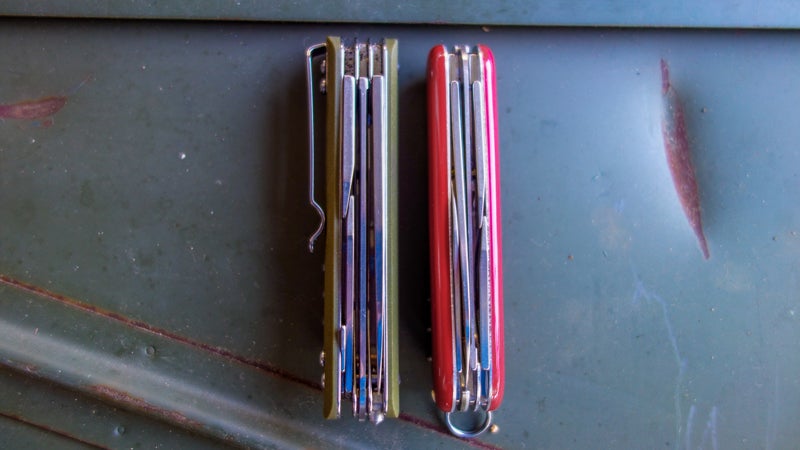
Construction
Victorinox houses its stainless steel tools in stainless steel liners backed by stainless steel springs. You can see a great illustration of these parts in Todd McLellan’s photo series, . Pinned to the outside of those liners are a pair of slick plastic handles.
Aping Victorinox’s design, Boker uses the stainless tool-liner-spring combo, but departs significantly by bolting G10 handle scales to the frame with torx screws. That may sound like a small difference, but it’s a huge part of what makes the Boker a better tool. G10 is made from layers of fiberglass mesh set in an epoxy resin. It’s an incredibly strong material that provides your hand with good traction, wet or dry. So, not only are the Boker’s handles made from a stronger, longer lasting material, but they also offer a much more secure grip, particularly if your hands are wet, cold, or sweaty. On any tool with sharp parts, that’s a big help.
The ability to easily remove those scales and disassemble the knife could also be a boon to some users. Being able to easily clean, lubricate, or repair the knife yourself may increase its service life or enable you to perform a field repair that would be next to impossible with the Victorinox.
Winner: Boker
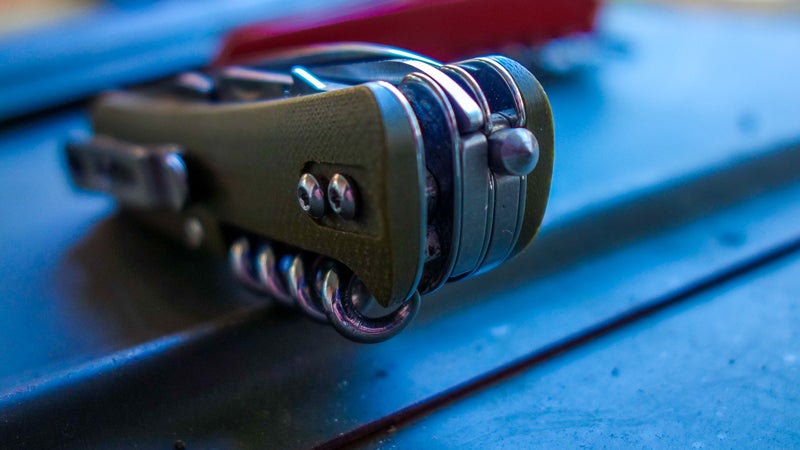
Tool Set
Both knives have a big blade, a wood saw, a bottle opener, large and small screw drivers, corkscrew, and awl. More or different combinations of tools are available in similar knives from both companies.
Additionally, the Victorinox has a small blade, can opener, tweezers, and a toothpick. The Boker ditches both the small blade and the can opener in favor of a serrated, angled line cutter, while its handle design does not include the ability to insert tweezers or a toothpick. It also features a carbide glass breaker hard-mounted to one end of the tool that doesn't fold into the handle.
While the ability to easily and safely open a can is one of the Swiss Army knife’s original merits and is a missed capability on the Boker (I’ve grabbed a Swiss Army knife for many camping trips just to open cans and wine bottles), you won’t mourn the loss of the small blade. The Boker’s line cutter, angled out from the handle at 30 degrees or so to form a hook, makes quick work of paracord and even thin metal wire.
The usefulness of the glass breaker in an emergency cannot be overstated. Since using another knife equipped with one to (I was able to smash the window and cut his seatbelt as the truck lay precariously upside down against a tree, at risk of falling farther), it's now a feature I want on any knife I carry. In addition to car emergencies, the glass breaker could save crucial seconds should you ever need to flee a building through locked or otherwise inaccessible doors or windows. Just look around any urban environment and imagine that every piece of glass is now an available exit.
The tools in both knives are of largely equivalent quality and size. Both saws can cut through small branches, while bottles of wine and beer are opened with equal ease. The curvature of the flat blade on the Boker’s awl is perhaps a little superior for enlarging holes, but the Victorinox makes up for that with a thinner, less rounded small driver blade on the end of its can opener. The Boker’s (mounted on the end of the line cutter) is disappointingly thick and round, making it hard to turn very small screws.
Winner: Boker. The line cutter and glass breakers add a welcome level of usefulness, both every day and in emergencies. But you won’t be able to use it to adjust your glasses.
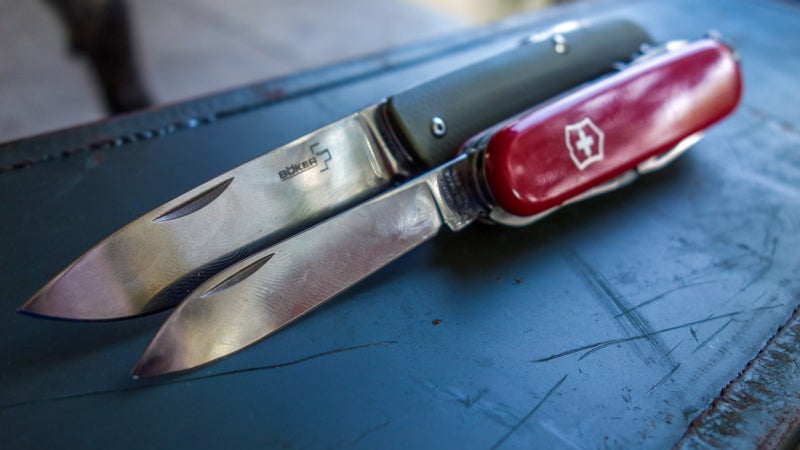
Blades
Victorinox does not disclose the source or hardness of its steel, but it’s said to be around 56 on the . Both large and small blades on the Swiss Army knife arrive razor sharp, but they don’t stay that way for long. But hey, at least they’re easy to sharpen. (Making the blade from cheaper steel is a big reason why this knife is so affordable.) Boker uses Sandvik’s 12C27 stainless steel for its knife blade. That’s a harder steel, with a Rockwell value of 58-60, so it retains its razor edge for longer, but it's just as easy to sharpen.
As you can see, while both blades are very close in length and shape, the Boker’s is a bit wider. That allows a greater sweep in its belly, making it a little superior at slicing duties: it draws through the material being cut a little easier.
A big weakness of this design of pocket knife, and a major reason for carrying a modern-knife design, is speed and ease of deployment. With both knives, it takes two hands and several seconds to deploy a blade (or any other tool): you hold the knife in one and pick at the little indents with your finger nail.
Winner: Boker. But not by much.
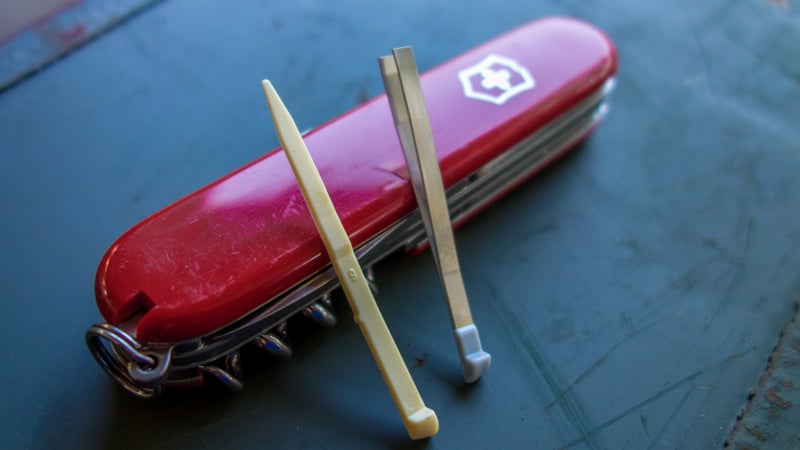
Pocketability
The Swiss Army knife is a little oblong piece of plastic and steel that falls into the bottom of a pocket or pack and swims around down there with your keys. It’s a slick little package, but that slickness also means it’s easily lost.
The Boker has a pocket clip. And not just any pocket clip, but a really, really good, deep carry one that can be moved between two locations. That means it rides securely and comfortably in your pocket and can be grabbed without digging through keys or other odds and ends. Especially relevant if your pants are anything approaching tight.
You can find someone who will fit a deep carry pocket clip to a Swiss Army knife on for around $30. Or you can attach a clip to the tool’s keyring. Neither solution is as good as the clip the Boker comes with, stock.
Winner: Boker
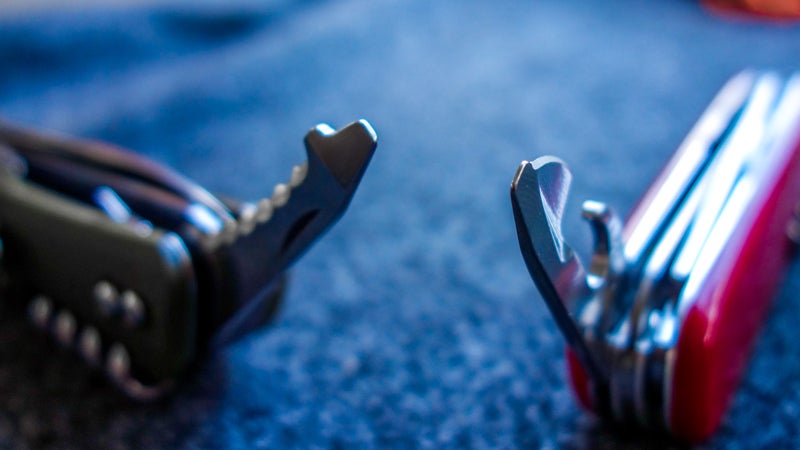
Which Knife’s For You?
The Swiss Army knife remains a great little gadget. Pick the one with the tools that fit your needs and it’ll be a useful companion through years of hiking, hunting, camping, and fishing. And it will do that very affordably and with universal availability.
But—fitted with that convenient pocket clip, equipped with a more diverse array of capabilities, more secure in your hand, and even featuring a named steel for its blade—the Tech-Tool more than justifies its premium price tag.
You’ll find City, Outdoors, and Carbon models of seven versions of the Boker. Those names refer to the handle colors and materials. is fitted with a black G10 handle, the (pictured) with green G10, and the with carbon fiber. Tool sets range from a single blade to versions that include pliers and scissors in addition to what you see here.
